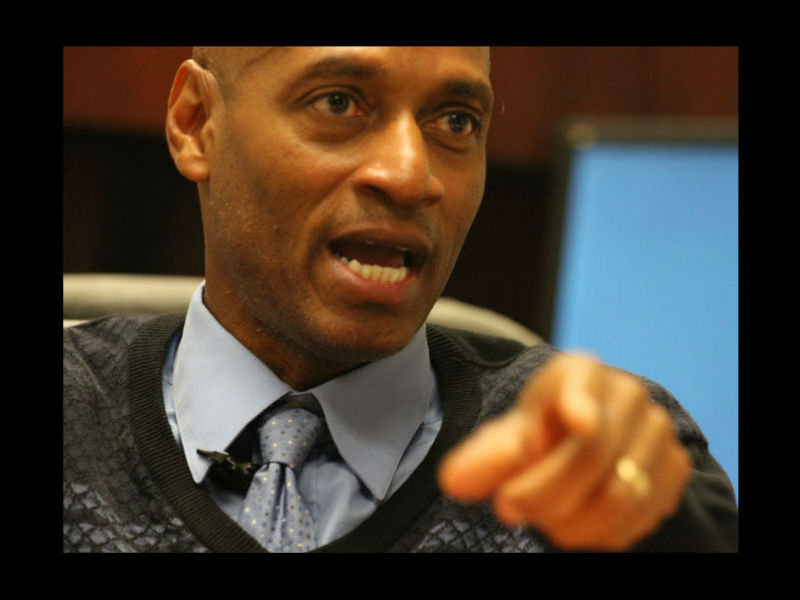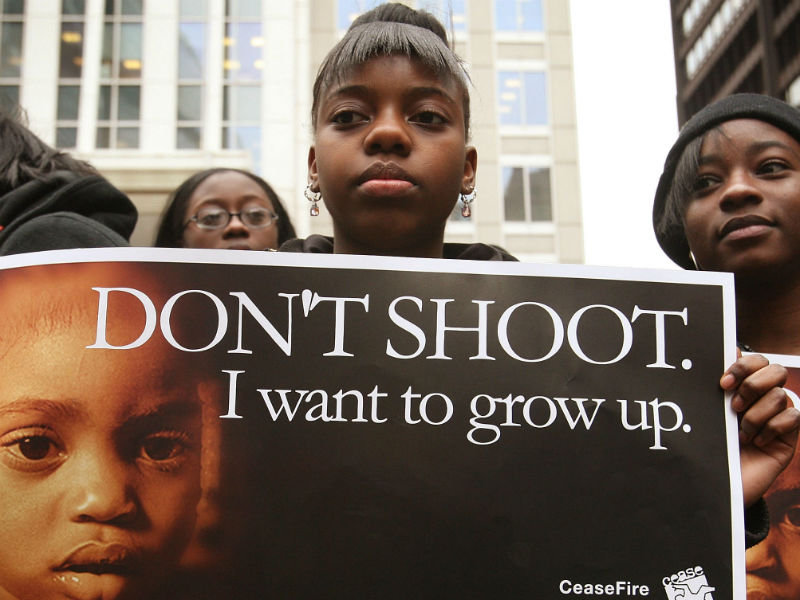Last summer there was a sudden increase in shootings, contributing to a year-end total of 105 homicides in Milwaukee.
At the time of writing there have been 39 homicides in 2014, five fewer than last year at the same time. Some new initiatives seek to reduce violence in the city, while groups throughout the city continue previous efforts to put a stop to the shootings.
Safe and Sound was created in 1998 to prevent violence in the city using a three-pronged approach that involves youth development, community organizing and partnering with law enforcement agencies, Katie Sanders, executive director of Safe and Sound, said.
The organization funds after-school programs that provide a safe place for youth in the city while also having a curriculum that "focuses on anti-crime, anti-drug, anti-gang and health choices rather than negative influences in their neighborhoods," Sanders said.
Among the organizations Safe and Sound partners with for after-school programs are Holton Youth and Family Center, Boys and Girls Clubs, City on a Hill, Running Rebels and United Community Center.
Community organizers go door-to-door in neighborhoods and develop a rapport with residents while informing them about resources. From there the community organizers will do things like coordinate block parties in order for neighbors to get to know each other or block cleanups to take care of litter.
"By starting with those somewhat simple things we can understand what are some of the more severe problems in the neighborhood and then really build the capacity of the residents to report crime," Sanders said.
Safe and Sound also partners with the Milwaukee Police Department, the District Attorney’s office, Department of Corrections, City Attorney’s office, Department of Neighborhood services and other organizations for Community Prosecution Units. Safe and Sound coordinators in the Community Prosecution Units target nuisance properties in neighborhoods and address them before violent crime occurs at those locations.
"The really critical role for the CPU coordinator is to provide information back to the community so once there is an arrest made or an eviction whatever the result of the nuisance property’s closure is they can go back to the residents in the neighborhood and say, ‘This is what happened. We took care of this’," Sanders said.
"Our role is to build police and city resource legitimacy and the trust between the residents and those organizations."
MPD Chief Ed Flynn is the past chair of the organization’s board of directors.
Safe and Sound’s other programs include working in the 53208 zip code to create drug free communities, which is funded through a federal grant. The program reduces alcohol and marijuana use among youth and their families. Safe and Sound also has small-group discussions called Youth/Police listening circles between young Milwaukeeans and police officers.
"When youth only encounter police because their dad or brother or uncle or friend is being arrested there obviously becomes a negative association with the police," Sanders said.
The organization does pre- and post-testing of both youth and police involved in the listening circles and has found the dialogue "significantly decreases the negative feelings between the relationship" among both parties, Sanders said.
Safe and Sound is not the only organization in Milwaukee working to reduce violence in the city. Churches and faith leaders are also involved in social justice and violence prevention efforts in the city. While the rector at St. James Episcopal Church on 9th and Wisconsin, Rev. Debra Trakel worked on ministries for the homeless in the city.
"Issues of poverty and issues of violence get linked when poverty makes for desperation," Trakel, now at St. Christopher’s Episcopal Church in River Hills, said in a phone interview.
"Desperation breeds violence. If you have something I want, I will do what I can to take it," she said.
Trakel said people were sleeping on the grounds of St. James Episcopal Church where it was perceived to be and was safer. It was also realized people were less likely to get into an altercation on the grounds of the church as opposed to being in a situation such as sleeping under a bridge.
St. James Episcopal Church still has ministries such as Sundries from the Avenue through which items such as toothpaste and toothbrushes, soap and shampoo are distributed to people who receive meals at the meal ministry at St. James.
"Those people with their full stomachs, gloves on their hands, water bottles in their hands were much less likely to use violence," Trakel said.
Trakel said the church took the stance to speak on behalf of the voiceless.
"If you are voiceless, sometimes you use violence," she said. "So as part of our ethos we spoke on behalf of the voiceless."
There is still work ahead for groups like Safe and Sound and its partners. Safe and Sound is in the process of preparing a strategic plan, expected to be approved by the organization’s board in September. This will likely result in the services from the organization becoming "a little more strategic and data driven," Sanders said.
Sanders also feels the role of drugs and the drug trade in Milwaukee is also a large challenge in preventing violence, particularly with gang involvement in the drug trade.
"We see youth being recruited younger and younger," Sanders said. "I would say the early age of recruitment and the role that drugs and the drug trade play in that is very significant. We really need to bolster our youth agencies and the partnerships they have with the police and the district attorney’s office.
"What we see is a lot of success in being able to divert youth out of negative paths where there is that communication between the youth agency and the law enforcement."
A historical perspective
There were 106 deaths classified as murders in Milwaukee in 2013. That was up from 92 in 2012, 87 in 2011 and it was the highest number of homicides in the city since 2005 when 122 murders occurred.
This year has seen murders such as killing of 10-year-old Sierra Guyton, who was shot on the playground at Clarke Street School on May 21.
Historically Milwaukee’s murder rate has fluctuated, said Lt. Mark Stanmeyer of the Milwaukee Police Department.
Over the past 14 years Milwaukee has experienced two significant peaks with the murder rates. In 2005 there were 122 murders, up from 87 in 2004; 2010 saw 95 murders, which was up from 72 in 2009.
What made 2013 an abnormal year was how quiet things seemed during the first half of the year, according to Mayor Tom Barrett.
"We were on a pace through the end of June to actually have lower homicide numbers," Barrett said. "July and more specifically August and September all hell broke loose. And we had a period there, probably six or seven-week period, where it was almost a daily occurrence we were having serious shootings. It was just horrific."
Barrett receives a text message every time a shooting occurs in the city. He also serves on the board of directors of Safe and Sound alongside Milwaukee County Executive Chris Abele, District Attorney John Chisholm and Milwaukee County Sherriff David Clarke.
Although homicides are currently down in the city the issue still comes in about how there are still people are being killed in Milwaukee.
Response from the City
Barrett sat in his office on the second floor of City Hall, as the sound of construction outside of the building provided ambient background noise. During his nearly 10 years as mayor of Milwaukee Barrett has created a variety of initiatives to tackle violence in the city, including Ceasefire Sabbath, which occurs every May.
"It’s something that I decided on my own probably back in 2005 that it was important to bring the faith community into our efforts, comprehensive efforts, to reduce crime and violence in the city of Milwaukee," Barrett said.
"I felt then and I continue to believe that there are certain people that the police can reach, there are certain people city government can reach, whether it’s the mayor or aldermen, other elected officials, But there’s a group of people that the churches can reach."
Barrett decided to have Ceasefire Sabbath occur every may close to Mother’s Day and before Memorial Day weekend, the beginning of the summer in Milwaukee, after having a conversation with former Supreme Court justice Janine Geske. Geske had worked with people previously incarcerated and found the person who often was able to reach them was their mothers.
The response to Ceasefire Sabbath from faith leaders in Milwaukee has been very positive, according to Barrett.
The mayor’s office also recently launched a new anonymous hotline for residents to report illegal guns. The hotline was created after looking at statistics on shootings to which MPD responded.
Barrett said more shootings were reported to MPD via the Shot Spotter technology -- which uses sensors to triangulate the location of shots fired -- than through calls to the police department.
"As I delved into that more deeply one of the responses I got was that people were afraid to call in," Barrett said. "And so we thought, ‘Let’s find an anonymous way for people to call in so we can get information on illegal guns’."
As of July 8, about 55 people have called the hotline, Barrett said.
During 2013 ministers in the city who wanted to do something about the shootings approached Barrett. That led to the creation of the gun buyback program as well as ministers in Milwaukee going to the citizen’s academy at the Milwaukee Police Department’s academy to learn how to work with police, he said.
The Milwaukee Police Department has not changed its strategy this year, continuing the community and data-based policing method the department has been using, according to Stanmeyer.
Ald. Robert Donovan, who represents the city’s eighth district on the South Side, thinks more could be done to address the violence in the city.
"I think the bottom line is it’s not working," said Donovan, a frequent critic of the mayor. "We need to try new things, so I’m not going to condemn those efforts."
Donovan said he has seen how the violence, largely concentrated on the city’s near North Side, has affected his constituents on Milwaukee’s South Side.
"Constituents have told me they’re considering moving out of Milwaukee," he said. "People have complained to me about increases in insurance rates."
The Milwaukee Police Department is focused on specific areas when it comes to patrols. According to Stanmeyer, 10 percent of the offenders are committing 50 percent of the crime in the city, 94 percent of the victims in homicides had a criminal history and 92 percent of the offenders in crimes had previous arrests with the MPD.
"We know the violent crime is focused on areas affected by poverty, foreclosure and public health issues," Stanmeyer said.
Donovan believes one way to help tackle the violence in the city is to fill police vacancies.
"In my mind any meaningful plan has to include additional officers to fill police vacancies and get that number of officers able to stabilize those neighborhoods," he said. "And then and only then I think people are able to get involved."
There are currently 120 people enrolled in the Milwaukee Police Department’s academy to become officers, according to Stanmeyer and the mayor’s office.
The Milwaukee Police Department is currently working with the Federal Bureau of Investigation on a task force to target gang activity in the city, Stanmeyer said.
The first of many planned operations between the two agencies was the raid on the 29 Taliban Gang that occurred on June 17. Stanmeyer said there are plenty more operations to come.
The mayor’s office is going to continue to work on with various agencies and groups to address the violence in the city.
"In the recent past I’ve met with other officials, law enforcement officials in particular, including the district attorney, U.S. attorney, the police chief, the FBI, ATF and we’ve worked to see how we can best coordinate our activities," Barrett said. "We’ll continue to do that, we’ll be meeting again in the near future."
Barrett also said the city plans to continue to work with churches and youth groups as well as any other interested groups to connect with young men to prevent violence in the city.
As 2014 continues there can be hope for fewer people who are not only shot in Milwaukee, but also killed. The various efforts from people in the city have already impacted many lives and will continue to do so, potentially continuing to reduce the number of homicides.







